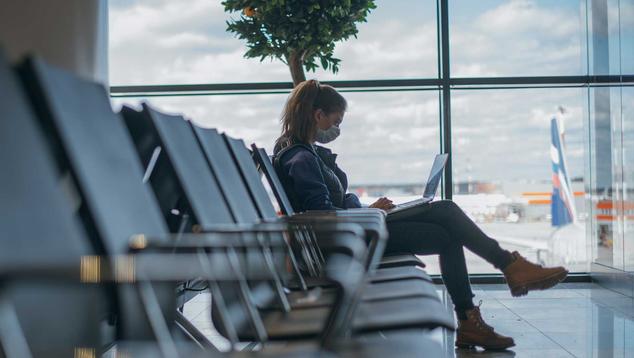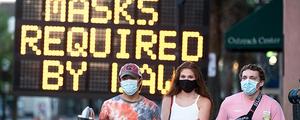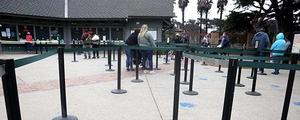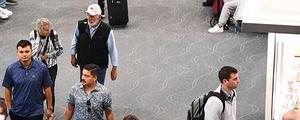Story Highlights
- Responses vary by age; 69% of air travelers aged 55+ now uncomfortable
- Many who are comfortable flying are more hesitant about long flights
Editor's Note: The research below was conducted in partnership between Franklin Templeton and Gallup.
WASHINGTON, D.C. -- Indicating how severely COVID-19 has disrupted the airline industry in its peak travel season, about half of American adults who flew at least once a year before the pandemic (52%) currently say they would not be comfortable flying. This figure varies significantly by age and political affiliation; most notably, 69% of American air travelers aged 55 and older say they would not be comfortable flying, compared with 33% of those aged 18 to 34.
| Not comfortable flying at all | |||||||||||||||||||||||||||||||||||||||||||||||||||||||||||||||||||||||||||||||||||||||||||||||||||
|---|---|---|---|---|---|---|---|---|---|---|---|---|---|---|---|---|---|---|---|---|---|---|---|---|---|---|---|---|---|---|---|---|---|---|---|---|---|---|---|---|---|---|---|---|---|---|---|---|---|---|---|---|---|---|---|---|---|---|---|---|---|---|---|---|---|---|---|---|---|---|---|---|---|---|---|---|---|---|---|---|---|---|---|---|---|---|---|---|---|---|---|---|---|---|---|---|---|---|---|
| % | |||||||||||||||||||||||||||||||||||||||||||||||||||||||||||||||||||||||||||||||||||||||||||||||||||
| Overall | 52 | ||||||||||||||||||||||||||||||||||||||||||||||||||||||||||||||||||||||||||||||||||||||||||||||||||
| 18-34 | 33 | ||||||||||||||||||||||||||||||||||||||||||||||||||||||||||||||||||||||||||||||||||||||||||||||||||
| 35-54 | 51 | ||||||||||||||||||||||||||||||||||||||||||||||||||||||||||||||||||||||||||||||||||||||||||||||||||
| 55+ | 69 | ||||||||||||||||||||||||||||||||||||||||||||||||||||||||||||||||||||||||||||||||||||||||||||||||||
| Among those who flew at least once in the year prior to the pandemic | |||||||||||||||||||||||||||||||||||||||||||||||||||||||||||||||||||||||||||||||||||||||||||||||||||
| Franklin Templeton-Gallup Economics of Recovery Study, July 2-14, 2020 | |||||||||||||||||||||||||||||||||||||||||||||||||||||||||||||||||||||||||||||||||||||||||||||||||||
These results are based on more than 10,000 web-based surveys completed July 2-14 as part of the Franklin Templeton-Gallup Economics of Recovery Study. This study is conducted via Dynata's opt-in web panel, and the sample has been adjusted statistically to ensure it represents key subgroups in their proper proportions of the U.S. adult population.
For the U.S. airline industry to recover from the current crisis, it will be critical for industry leaders to have reliable information about when and under what conditions passengers will feel comfortable returning to air travel. Differences in comfort level by age group might be expected given that older adults are more vulnerable to severe illness from COVID-19. But the extent of those differences is especially noteworthy given that baby boomers and retirees are important market segments for leisure travel.
Political affiliation also shows significant ties to U.S. air travelers' attitudes about flying. Currently, about six in 10 Democrats (59%) say they would not be comfortable flying at all, compared with about four in 10 Republicans (42%). Independents lean more toward Democrats' views, at 54%.
Flight Length Has Some Effect on Comfort Level
Many air travelers who feel comfortable with flying are more hesitant about longer flights. When asked whether they would currently be comfortable taking flights of various durations, almost half say they would be OK with taking one that lasted less than two hours (44%) or two to three hours (47%). However, this figure drops to just over one-fourth (27%) for flights lasting four to six hours and to about one-fifth (21%) for those longer than six hours.
| Yes, comfortable | |||||||||||||||||||||||||||||||||||||||||||||||||||||||||||||||||||||||||||||||||||||||||||||||||||
|---|---|---|---|---|---|---|---|---|---|---|---|---|---|---|---|---|---|---|---|---|---|---|---|---|---|---|---|---|---|---|---|---|---|---|---|---|---|---|---|---|---|---|---|---|---|---|---|---|---|---|---|---|---|---|---|---|---|---|---|---|---|---|---|---|---|---|---|---|---|---|---|---|---|---|---|---|---|---|---|---|---|---|---|---|---|---|---|---|---|---|---|---|---|---|---|---|---|---|---|
| % | |||||||||||||||||||||||||||||||||||||||||||||||||||||||||||||||||||||||||||||||||||||||||||||||||||
| Less than two hours | 44 | ||||||||||||||||||||||||||||||||||||||||||||||||||||||||||||||||||||||||||||||||||||||||||||||||||
| Two to three hours | 47 | ||||||||||||||||||||||||||||||||||||||||||||||||||||||||||||||||||||||||||||||||||||||||||||||||||
| Four to six hours | 27 | ||||||||||||||||||||||||||||||||||||||||||||||||||||||||||||||||||||||||||||||||||||||||||||||||||
| More than six hours | 21 | ||||||||||||||||||||||||||||||||||||||||||||||||||||||||||||||||||||||||||||||||||||||||||||||||||
| Categories not mutually exclusive; among those who flew at least once in the year prior to the pandemic and do not say they are currently uncomfortable flying altogether | |||||||||||||||||||||||||||||||||||||||||||||||||||||||||||||||||||||||||||||||||||||||||||||||||||
| Franklin Templeton-Gallup Economics of Recovery Study, July 2-14, 2020 | |||||||||||||||||||||||||||||||||||||||||||||||||||||||||||||||||||||||||||||||||||||||||||||||||||
This greater reluctance to return to longer flights implies carriers that provide cross-country or international flights may have to take additional precautions to bring customers back. International carriers already face extensive travel restrictions, as most countries worldwide are currently closed to U.S. travelers.
53% of Air Travelers Willing to Pay Extra Fee for Empty Companion Seat
Airlines are testing various ways to help customers feel more comfortable flying, including enhanced onboard cleaning and requiring passengers to wear face masks during flights. Another common measure is finding ways to put more space between passengers. Delta and JetBlue are currently guaranteeing empty middle seats, while Southwest Airlines promises to book flights at no more than two-thirds full.
U.S. air travelers were asked whether they would be willing to pay fees of different amounts to guarantee they would have an empty seat next to them. Currently, almost half (47%) indicate they would be unwilling to pay any amount. Another 47% say they would find it acceptable to pay a fee of under $100 to ensure an empty seat next to them. These figures drop significantly for amounts of $100 or more, although about three in 10 air travelers (29%) say they would pay $100 to $149 for an empty companion seat and almost two in 10 (18%) say they would pay $250 or more -- a 50% increase over their original ticket price.
| Yes, would pay | |||||||||||||||||||||||||||||||||||||||||||||||||||||||||||||||||||||||||||||||||||||||||||||||||||
|---|---|---|---|---|---|---|---|---|---|---|---|---|---|---|---|---|---|---|---|---|---|---|---|---|---|---|---|---|---|---|---|---|---|---|---|---|---|---|---|---|---|---|---|---|---|---|---|---|---|---|---|---|---|---|---|---|---|---|---|---|---|---|---|---|---|---|---|---|---|---|---|---|---|---|---|---|---|---|---|---|---|---|---|---|---|---|---|---|---|---|---|---|---|---|---|---|---|---|---|
| % | |||||||||||||||||||||||||||||||||||||||||||||||||||||||||||||||||||||||||||||||||||||||||||||||||||
| Less than $100 | 47 | ||||||||||||||||||||||||||||||||||||||||||||||||||||||||||||||||||||||||||||||||||||||||||||||||||
| $100-$149 | 29 | ||||||||||||||||||||||||||||||||||||||||||||||||||||||||||||||||||||||||||||||||||||||||||||||||||
| $150-$249 | 22 | ||||||||||||||||||||||||||||||||||||||||||||||||||||||||||||||||||||||||||||||||||||||||||||||||||
| $250 or more | 18 | ||||||||||||||||||||||||||||||||||||||||||||||||||||||||||||||||||||||||||||||||||||||||||||||||||
| No amount selected | 47 | ||||||||||||||||||||||||||||||||||||||||||||||||||||||||||||||||||||||||||||||||||||||||||||||||||
| Categories not mutually exclusive; among those who flew at least once in the year prior to the pandemic | |||||||||||||||||||||||||||||||||||||||||||||||||||||||||||||||||||||||||||||||||||||||||||||||||||
| Franklin Templeton-Gallup Economics of Recovery Study, July 2-14, 2020 | |||||||||||||||||||||||||||||||||||||||||||||||||||||||||||||||||||||||||||||||||||||||||||||||||||
Importantly, offering empty seats for a fee is much less acceptable to older air travelers than younger people; 36% of those aged 55 and older say they would pay something for an empty seat, versus 64% of those aged 18 to 34. The difference suggests such offerings are less likely to be effective at encouraging older people to fly again.
Implications
Air travel is among the industries hit hardest by COVID-19, as airlines face pandemic travel restrictions in addition to widespread concerns about potential exposure among their customer base. The CARES Act passed in March devoted some relief funds to the U.S. airline industry, under the condition that passenger airlines promise to not lay off employees until Oct. 1. With the virus continuing to spread at a rapid rate, that provision may result in tens of thousands of industry layoffs this fall.
Knowing that older and long-distance passengers are among the least likely to feel comfortable returning to the air in the short term, for example, may help airlines adjust their marketing strategies by targeting other segments or providing additional safety precautions for those groups. In the coming months, the Franklin Templeton-Gallup Economics of Recovery Study will track changes in these measures and a range of others gauging Americans' attitudes toward resuming pre-COVID behaviors, with the goal of better informing the path to recovery.
To receive ongoing updates about findings from the Franklin Templeton-Gallup Economics of Recovery Study, please sign up here. To read the project announcement press release, please visit this page.




